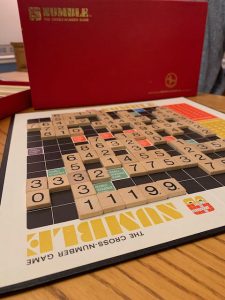When I was about 10 years old, the board game company Selchow and Righter came out with a new product called Numble.
It looked like Scrabble, but instead of letters, the tiles had numbers on them. At that age, I loved arithmetic and was quite good at calculating things in my head, so my parents bought a Numble set for my birthday.
Like Scrabble, on each turn a player had to put down a series of tiles from their rack. The trick was that the digits in that series had to add up to a multiple of three (e.g. 1+3+5+9+9=27). To make things harder, there were spaces that would double or triple a number, while others could do the same to your entire sequence, and you had to factor that in to ensure your total was still divisible by three.
I took to the game right away and challenged my mother, who was fairly good at math and enjoyed playing with me. Not so for my father — a brilliant historian, teacher, and chess player — who got frustrated by the multiplier squares. Bottom line: Mom was better at math, which is why she handled the family’s finances. I became mildly obsessed with Numble for a while, often just pulling tiles out at random and figuring out where to play them on the board to get the highest score.
Unfortunately, Numble was not a big hit, so Selchow and Righter stopped making the game after a few years. Fortunately, I found an original set on eBay recently and bought it to coincide with my daughter visiting us.
Like me, she had an aptitude for numbers at an early age, so I taught her how to identify mathematical times on the clock and a bunch of fun shortcuts to solving problems. It wasn’t until her late high school years that advanced classes in trigonometry and pre-calculus made her begin claiming she hated math. She’d still tell you that today, but the truth is she remains pretty quick at the basics of arithmetic — addition, subtraction, multiplication, and division.
The Numble box, board, and tiles I purchased were still in good condition, so we spread it out on our dining room table and started to play. It took us both a while to get up to speed, and I got off to a big lead early on. However, late in the game, my daughter cleverly played two different multiplier squares on the same sequence, causing her total to rocket past mine, and I never caught up.
Still, we both ended up with smiles on our faces, partly from the experience, and partly from seeing her get a kick out of an obscure board game I remembered enjoying fifty years ago (or fifty-one, to make it a multiple of three).

